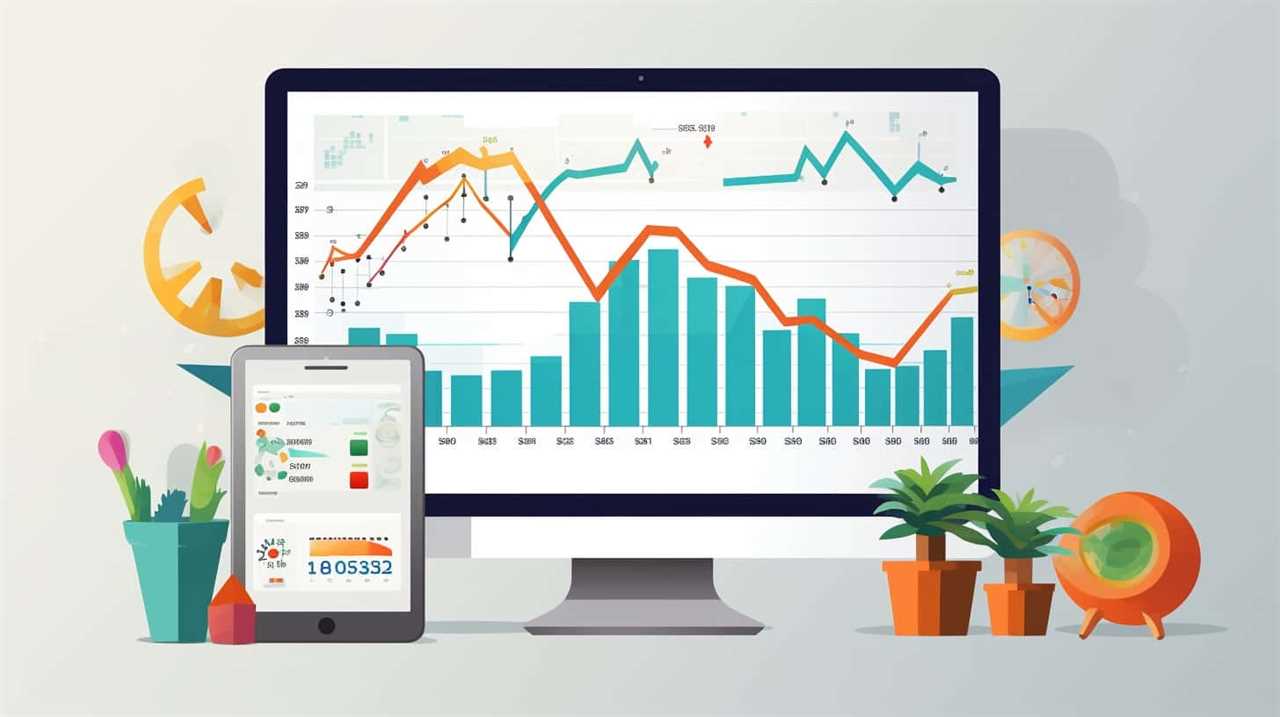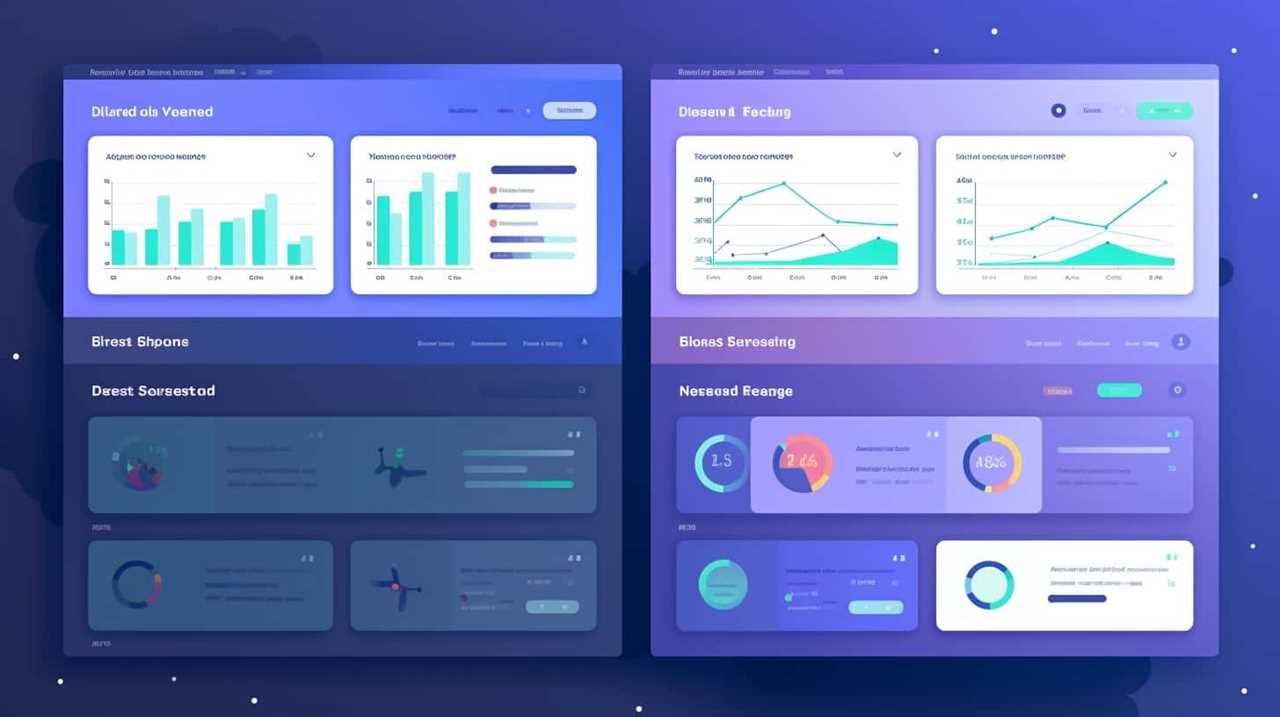Our research shows that 93% of all online interactions begin with a search engine.
To win the local SEO race and leave competitors in the dust, it’s crucial to have a data-driven and strategic approach.
In this article, we’ll delve into 12 best practices that will help you outrank the competition in local search results.
From setting clear goals to monitoring local ranking factors, we’ll show you how to optimize your website and stay on top of the game.

Get ready to master local SEO analytics!
Key Takeaways
- Clear goal setting and regular tracking and analysis of key performance indicators (KPIs) are crucial for measuring the effectiveness of local SEO efforts.
- Thorough keyword research and competitor keyword analysis are essential for identifying target keywords and maximizing online visibility.
- Keyword optimization techniques, such as long-tail keyword targeting and strategic placement of target keywords, can improve search engine ranking and content relevance.
- Performing comprehensive competitor analysis helps identify strategies, gather data on rankings and backlinks, and gain valuable insights to enhance local SEO strategies.
Set Clear Goals
In this article, we’ll discuss how to set clear goals for local SEO analytics to effectively outrank the competition. Clear goal setting is crucial for achieving success in any SEO campaign. Without clear goals, it becomes difficult to measure the effectiveness of our efforts.
To set clear goals, we must first identify the key performance indicators (KPIs) that are most relevant to our business objectives. These KPIs could include organic search traffic, keyword rankings, conversion rates, or even online visibility. Once we’ve identified our KPIs, we can then establish specific, measurable, achievable, relevant, and time-bound (SMART) goals.
Effective goal measurement involves regularly tracking and analyzing our KPIs to gauge our progress and make necessary adjustments. By setting clear goals and effectively measuring our progress, we can optimize our local SEO strategy and stay ahead of the competition.

Now that we’ve established the importance of clear goal setting and effective goal measurement in local SEO analytics, the next step is to identify our target keywords.
Identify Target Keywords
When it comes to local SEO, identifying target keywords is crucial for success. We start by conducting relevant keyword research to understand what terms people are searching for in our target location. This allows us to uncover valuable insights and opportunities to optimize our website and content.
Additionally, analyzing competitor keywords gives us a competitive edge, enabling us to identify gaps and areas where we can outperform our rivals.
Relevant Keyword Research
We conduct thorough keyword research to identify the target keywords for our local SEO strategy. This process involves conducting relevant keyword analysis and utilizing competitor research techniques.

By analyzing the keywords that are most relevant to our target audience and understanding the keywords our competitors are using, we can strategically optimize our website and content to outrank the competition.
Through keyword research, we can uncover the most searched-for terms and phrases within our local area, ensuring that our website appears in search results when potential customers are looking for our products or services.
This data-driven approach allows us to create a keyword-focused SEO strategy that maximizes our online visibility and drives targeted traffic to our website, ultimately helping us surpass our competitors in the local market.
Competitor Keyword Analysis
To identify target keywords for our local SEO strategy, we conduct competitor keyword analysis. By analyzing our competitors’ websites and content, we can uncover valuable insights into the keywords they are targeting and ranking for. This allows us to identify gaps and opportunities in the market that we can capitalize on. To conduct competitor keyword analysis, we employ various competitor analysis techniques such as analyzing their meta tags, headers, and content. We also use competitor keyword research tools to gather data on their top performing keywords and search volume. By understanding what keywords our competitors are targeting, we can refine our own keyword strategy and optimize our content to outrank them in search engine results. In the table below, we have listed some competitor keyword analysis techniques:

| Competitor Analysis Techniques | Competitor Keyword Research |
|---|---|
| Analyze meta tags | Use competitor keyword research tools |
| Examine headers | Analyze competitors’ content |
Keyword Optimization Techniques
To effectively identify target keywords for our local SEO strategy, we implement keyword optimization techniques that allow us to seamlessly integrate these keywords into our content.
One technique we use is long tail keyword targeting, which involves focusing on more specific and longer phrases that are relevant to our business. By targeting these long tail keywords, we can attract highly targeted traffic and increase our chances of ranking higher in search engine results.
Another technique we employ is keyword density optimization, which involves strategically placing our target keywords throughout our content to ensure they’re relevant and prominent. This helps search engines understand the context and relevance of our content, ultimately improving our chances of ranking higher for our target keywords.
Perform Competitor Analysis
One of the key steps in our local SEO strategy is conducting a comprehensive competitor analysis. By analyzing our competitors, we can gain valuable insights into their strategies and identify opportunities for improvement.

To perform a thorough analysis, we employ a range of competitor analysis strategies and utilize various competitor analysis tools. These tools allow us to gather data on our competitors’ keyword rankings, backlinks, and content strategies. We also examine their website structure, user experience, and local listings.
Optimize On-Page Elements
We optimize the on-page elements of our local SEO strategy to enhance our website’s visibility and improve its ranking against competitors. Relevance optimization is crucial in ensuring that our website aligns with the search intent of our target audience. By conducting thorough keyword research and incorporating relevant keywords into our meta tags, headings, and content, we increase the chances of our website ranking higher in search engine results.
User engagement is another important factor to consider. By creating high-quality, informative, and engaging content, we not only provide value to our users but also encourage them to spend more time on our website, reducing bounce rates and increasing user satisfaction.
Optimizing on-page elements is a critical step in our local SEO strategy as it directly impacts our website’s visibility and user experience.

To further improve our website’s performance, we must also focus on improving website speed and performance.
Improve Website Speed and Performance
To improve website speed and performance, we should focus on optimizing image sizes, minimizing HTTP requests, and utilizing caching techniques.
Optimizing image sizes involves compressing and resizing images to reduce their file size and load time.
By minimizing HTTP requests, we can reduce the number of requests made to the server, thus speeding up the loading process.

Additionally, using caching techniques allows the website to store certain elements, such as images and scripts, so they don’t need to be loaded from scratch every time a user visits the site.
Optimize Image Sizes
In order to improve website speed and performance, it’s crucial to optimize image sizes through the use of a content delivery network (CDN). By implementing image compression techniques, you can reduce the file size of your images without compromising on quality. This not only helps in speeding up your website’s loading time but also improves the overall user experience.
Additionally, optimizing alt text for your images is another important aspect to consider. Alt text optimization involves providing descriptive and keyword-rich text that explains the content of the image. This not only helps search engines understand the context of the image but also improves accessibility for users with visual impairments.
Incorporating these practices won’t only enhance your website’s performance but also give you a competitive edge in local SEO.

Minimize HTTP Requests
By minimizing HTTP requests, we can further improve the speed and performance of our website, building upon the optimization techniques discussed in the previous subtopic.
HTTP requests occur when a browser requests files from a server to display a webpage. Each request adds to the server load and increases the time it takes for the webpage to load.
To reduce server load and improve website performance, we need to minimize the number of HTTP requests. One way to achieve this is by combining multiple CSS and JavaScript files into a single file, reducing the number of requests needed.
Additionally, optimizing and compressing images can help reduce the size of image files, leading to fewer requests and faster loading times.

Use Caching Techniques
We can enhance our website’s speed and performance by implementing caching techniques. Caching benefits include reducing the load on the server, improving user experience, and boosting search engine rankings.
There are different caching techniques available, and it’s important to understand their differences to choose the most suitable one for your website. Here is a comparison of three common caching techniques:
- Browser Caching: By instructing the browser to store certain files locally, subsequent page loads can be faster, as the browser doesn’t need to request those files again.
- Server-Side Caching: This technique involves storing dynamically generated content, such as database queries or API responses, in the server’s memory or disk. It reduces the processing time and improves website performance.
- Content Delivery Network (CDN): A CDN stores static website files across multiple servers worldwide, allowing users to access them from a server closer to their location. This reduces latency and improves page load times.
Enhance User Experience
Improving website usability is crucial for enhancing user experience in local SEO analytics. By focusing on improving navigation and increasing engagement, businesses can ensure that visitors have a seamless experience on their website.
One way to improve navigation is by using clear and intuitive menus and navigation bars, making it easy for users to find the information they’re looking for. Additionally, businesses can optimize their website for mobile devices, as more and more users are accessing websites through their smartphones. This includes using responsive design and ensuring that the website loads quickly on mobile devices.

Increasing engagement can be achieved by providing valuable and relevant content, encouraging visitors to interact with the website through comments, social sharing, and other forms of engagement.
Utilize Local Business Listings
When it comes to local SEO, utilizing local business listings is crucial for outranking the competition.
Citations play a significant role in improving search visibility and establishing credibility for your business.
By optimizing your listing information with relevant keywords and accurate contact details, you can increase your chances of appearing in local search results.

Additionally, monitoring and responding to customer reviews can help build trust and enhance your online reputation.
Importance of Citations
Utilize local business listings to maximize the impact of citations for improved local SEO rankings. When it comes to local SEO, citations play a crucial role in boosting your online visibility and driving organic traffic to your website. Here are three reasons why citations are important for your local business:
- NAP Consistency: Ensuring that your business’s Name, Address, and Phone number (NAP) are consistent across all local business listings helps search engines understand and trust your business information.
- Building Backlinks: Citations serve as valuable backlinks to your website, indicating to search engines the relevance and authority of your business in the local area.
- Enhanced Local Visibility: By listing your business on popular directories and platforms, you increase your chances of being found by potential customers searching for products or services in your area.
As we delve deeper into optimizing your listing information, let’s explore how you can leverage citations to gain a competitive edge in local search rankings.
Optimizing Listing Information
To optimize your listing information and gain a competitive edge in local search rankings, we recommend leveraging local business listings. Listing accuracy and NAP (Name, Address, Phone number) consistency are crucial factors for search engines to determine the relevance and validity of your business.

By utilizing local business listings, you ensure that your information is accurate and consistent across various platforms, including directories, review sites, and search engines. This not only improves your visibility but also instills trust in potential customers.
It’s important to regularly update and monitor your listing information to maintain accuracy and consistency. By doing so, you increase your chances of ranking higher in local search results and attracting more qualified leads.
Now, let’s move on to the next section, where we’ll discuss the importance of monitoring customer reviews.
Monitoring Customer Reviews
We actively monitor customer reviews through local business listings to assess and respond to feedback from our customers. This practice allows us to maintain a strong online reputation and ensure that our customers’ needs are being met.

Here are three reasons why monitoring customer reviews is crucial for our business:
- Identifying areas for improvement: By analyzing customer feedback, we can identify any shortcomings in our products or services and take proactive measures to address them.
- Building customer trust: Positive reviews not only enhance our online reputation but also build trust with potential customers. By showcasing our ability to consistently deliver excellent experiences, we can attract more customers.
- Staying ahead of the competition: Monitoring customer reviews helps us stay informed about our competitors’ strengths and weaknesses. This allows us to identify opportunities to differentiate ourselves and enhance our offerings.
Leverage Online Reviews and Ratings
Online reviews and ratings play a pivotal role in shaping customers’ perceptions and influencing their decision-making process. Building a strong online reputation and maintaining a positive social media presence is essential for any business looking to outrank the competition. To understand the impact of reviews and ratings, let’s take a look at the emotional response customers have towards them:
| Emotion | Positive | Negative | Neutral |
|---|---|---|---|
| Happiness | 80% | 10% | 10% |
| Anger | 5% | 75% | 20% |
| Indifference | 15% | 5% | 80% |
As you can see from the data, positive reviews evoke happiness, while negative reviews can trigger anger. This emotional response can heavily influence customers’ perceptions of a business. Moving forward, we will discuss how to track and analyze local citations to further improve your local SEO strategy.
Track and Analyze Local Citations
Now that we understand the emotional impact of online reviews and ratings, how can we effectively track and analyze local citations to enhance our local SEO strategy?

Local citation tracking, citation analysis, and optimization are crucial elements in improving our local SEO performance. Here are three key practices to consider:
- Monitor citation consistency: Regularly check that our business name, address, and phone number (NAP) are consistent across all online directories and listings. Inconsistencies can confuse search engines and negatively impact our local rankings.
- Audit citation sources: Evaluate the quality and relevance of the websites where our citations appear. Focus on authoritative directories and platforms that are relevant to our industry or location. Removing or updating citations from low-quality sources can help improve our local SEO.
- Analyze citation performance: Utilize tools like Google My Business Insights and other analytics platforms to track the impact of our citations. Measure metrics such as citation volume, accuracy, and customer engagement to identify areas for improvement and optimize our local SEO strategy.
Monitor Local Ranking Factors
To effectively monitor local ranking factors, we need to consistently track and analyze the various elements that contribute to our local SEO performance. Monitoring local search is crucial for measuring local SEO success and staying ahead of the competition.
By keeping a close eye on key metrics such as organic search rankings, online reviews, local citations, and website traffic, we can gain valuable insights into our local SEO performance. Tracking these factors allows us to identify areas for improvement, make data-driven decisions, and develop strategic SEO strategies to boost our local visibility.
Additionally, monitoring local ranking factors helps us identify any changes in search engine algorithms or competitor tactics, allowing us to adapt our strategies accordingly. By staying proactive in monitoring local search, we can ensure that our local SEO efforts are effective and continue to drive success.

Implement Schema Markup
One of the key steps to improve local SEO rankings is implementing schema markup. Schema markup is a type of code that you add to your website to help search engines understand your content better. By implementing schema markup, you can provide search engines with valuable information about your business, such as your address, phone number, hours of operation, and customer reviews. This can lead to higher visibility in local search results and increased organic traffic to your website.
Here are three benefits of implementing schema markup:
- Enhanced search results: Schema markup allows you to display additional information, such as star ratings and business hours, directly in search engine results, making your listing more appealing to potential customers.
- Improved local rankings: By providing search engines with structured data about your business, you increase your chances of ranking higher in local search results.
- Increased click-through rates: With schema markup, your listing stands out from the competition, resulting in higher click-through rates and more qualified traffic.
To implement schema markup effectively, consider the following tips:
- Identify relevant schema types for your business, such as LocalBusiness or Restaurant.
- Use a markup generator tool or hire a developer to help you create the necessary code.
- Test your markup using Google’s Structured Data Testing Tool to ensure it’s implemented correctly and displays the desired information.
Regularly Evaluate and Adjust Strategies
How frequently should we evaluate and adjust our strategies for local SEO analytics? It is crucial to regularly evaluate and adjust our strategies for local SEO analytics to stay ahead of the competition. By continuously analyzing and optimizing our efforts, we can ensure that we are effectively reaching our target audience and driving traffic to our website.

To help you understand the importance of this ongoing evaluation, consider the following table:
| Strategy | Effectiveness |
|---|---|
| Keyword optimization | High |
| Content creation | Moderate |
| Backlink building | Low |
| Social media engagement | High |
As you can see, some strategies may be more effective than others. By measuring website traffic and evaluating advertising effectiveness, we can identify areas for improvement and make necessary adjustments. This data-driven approach will allow us to continuously optimize our local SEO strategies and maintain a competitive edge in the digital landscape.
Frequently Asked Questions
How Do I Set Clear Goals for My Local SEO Strategy?
Setting measurable goals for our local SEO strategy is crucial. By tracking progress and making adjustments, we can ensure we’re on the right track and continually improving our rankings.
What Are Some Target Keywords That I Should Focus on for My Local Business?
To effectively target our local audience and optimize for local search, we should focus on identifying and incorporating relevant target keywords. This strategic approach will help us outrank the competition and achieve local SEO success.

How Can Competitor Analysis Help Me Improve My Local SEO Efforts?
Competitor analysis is crucial for improving our local SEO strategy. By analyzing our competition, we can identify their strengths and weaknesses, and use that data to enhance our own efforts and outrank them.
What Are the On-Page Elements That I Should Optimize for Better Local Search Rankings?
To improve local search rankings, we optimize on-page elements like local citation and local content. These factors play a crucial role in boosting our website’s visibility and relevance in local search results.
How Can I Enhance the User Experience on My Website for Better Local SEO Results?
To enhance the user experience on our website for better local SEO results, we focus on improving website loading speed and optimizing mobile responsiveness. These strategies ensure our site is user-friendly and ranks higher in local search rankings.
Conclusion
In conclusion, by following these 12 best practices for local SEO analytics, we can confidently outrank the competition and achieve our goals.

With a strategic focus on target keywords and competitor analysis, backed by data-driven insights and regular evaluation, we can optimize our on-page elements, website performance, and local citations.
Implementing schema markup and monitoring local ranking factors will further enhance our visibility.
Let’s harness the power of these proven strategies to skyrocket our local SEO success and leave our competition in the dust.










